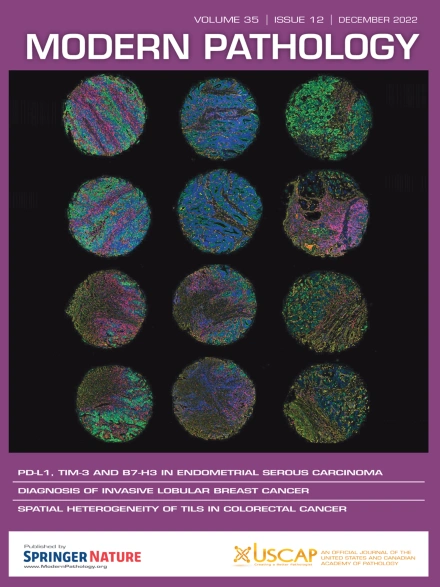皮肤纤维肉瘤隆突的综合临床病理和多组学特征显示PDGFD融合是一种独特的分子亚型,具有更好的生存率。
IF 5.5
1区 医学
Q1 PATHOLOGY
引用次数: 0
摘要
隆突性皮肤纤维肉瘤(DFSP)是一种局部侵袭性浅表间质肿瘤,以COL1A1::PDGFB融合为特征。最近,PDGFD被认为是一种不太常见的融合伴侣。然而,PDGFD和PDGFB融合DFSP之间的临床病理和分子差异在很大程度上仍然未知。在这项对363个dfsp的研究中,我们发现了10例PDGFD融合,其中2例与先前未描述的涉及EMILIN1基因的伴侣融合。多组学分析显示PDGFD融合DFSP与PDGFB融合DFSP的转录组学、表观基因组学和拷贝数特征不同。PDGFD融合DFSP具有较高的PDGFD表达,而PDGFB几乎不表达。两者都聚集在DFSP表观基因组集群中,但形成了一个不同的亚集群,甲基化差异影响成纤维细胞迁移基因。拷贝数分析显示,PDGFD融合DFSP形成了一个独特的亚群,与PDGFB融合DFSP相比,其总体拷贝数中性,生存率更高,而PDGFD融合DFSP主要在17和22号染色体的易位位点扩增。39例病例(包括文献中的29例)的汇总分析显示,PDGFD融合DFSP在女性中更为常见(71.8%对42.4%,p本文章由计算机程序翻译,如有差异,请以英文原文为准。
Comprehensive Clinicopathological and Multiomics Characterization of Dermatofibrosarcoma Protuberans Revealed PDGFD Fusion as Distinct Molecular Subtype With Better Survival
Dermatofibrosarcoma protuberans (DFSP) is a locally aggressive superficial mesenchymal neoplasm characterized by COL1A1::PDGFB fusion. Recently, PDGFD has been identified as a less common fusion partner. However, the clinicopathological and molecular differences between PDGFD-fusion and PDGFB-fusion DFSP remain largely unknown. In this study of 363 DFSP, we found 10 cases with PDGFD fusion, including 2 with a previously undescribed partner involving the EMILIN1 gene. Multiomics analysis showed distinct transcriptomics, epigenomics, and copy number features for PDGFD-fusion DFSP versus PDGFB-fusion DFSP. PDGFD-fusion DFSP had higher PDGFD expression and virtually no PDGFB expression. Both clustered into the DFSP epigenomic cluster but formed a distinct subcluster with differential methylation affecting fibroblast migration genes. Copy number analysis revealed that PDGFD-fusion DFSP formed a distinct subgroup with a generally copy number–neutral profile and better survival than PDGFB-fusion DFSP that was dominated by amplification at translocation sites in chromosomes 17 and 22. Pooled analysis of 39 cases (incorporating 29 from the literature) revealed that PDGFD-fusion DFSP was more common in women (71.8% vs 42.4%, P < .001), occurred at a lower age (median, 37 years vs 45 years, P < .01), and had a higher chance of occurrence at the breast (25.6% vs 2.3%, P < .001). PDGFD-fusion DFSP also tended to center predominantly in the subcutis (63.6% vs 30%, P < .001), had a circumscribed border (50% vs 19.2%, P < .001), was smaller in size (3 cm vs 3.5 cm, P = .017), and had a lower mitotic count (median, 1 vs 3 per 10 high-power fields, P = .03). Overall, our study provided detailed multiomics characterization of PDGFD-fusion DFSP with significant clinicopathological and diagnostic implications.
求助全文
通过发布文献求助,成功后即可免费获取论文全文。
去求助
来源期刊

Modern Pathology
医学-病理学
CiteScore
14.30
自引率
2.70%
发文量
174
审稿时长
18 days
期刊介绍:
Modern Pathology, an international journal under the ownership of The United States & Canadian Academy of Pathology (USCAP), serves as an authoritative platform for publishing top-tier clinical and translational research studies in pathology.
Original manuscripts are the primary focus of Modern Pathology, complemented by impactful editorials, reviews, and practice guidelines covering all facets of precision diagnostics in human pathology. The journal's scope includes advancements in molecular diagnostics and genomic classifications of diseases, breakthroughs in immune-oncology, computational science, applied bioinformatics, and digital pathology.
 求助内容:
求助内容: 应助结果提醒方式:
应助结果提醒方式:


